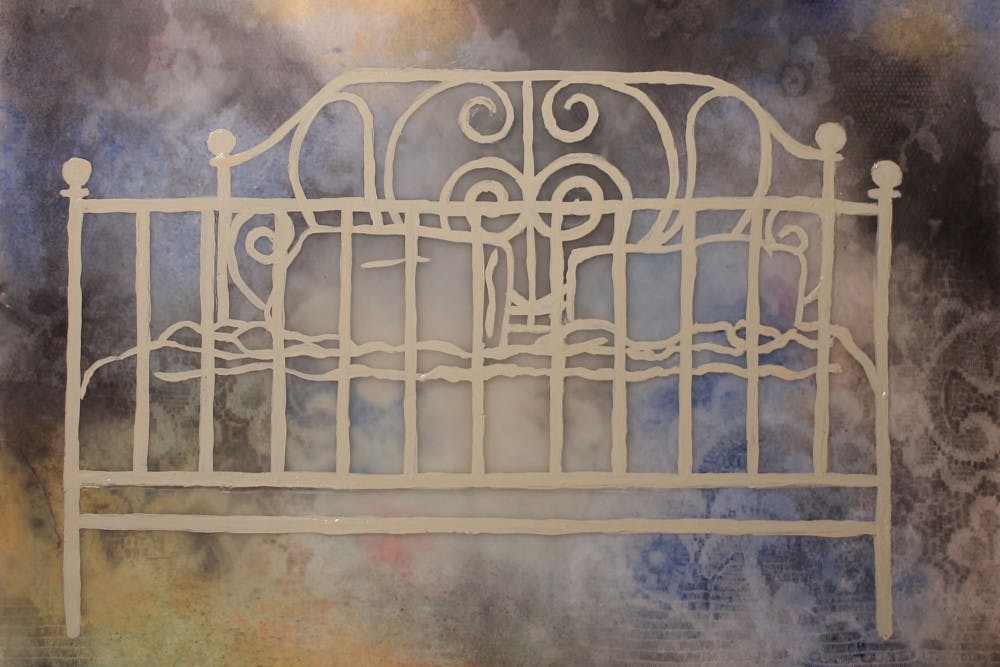Childbirth is often discussed from the lens of “the miracle of life,” where everything is complicated and painful until the magical moment when a mother is holding her baby in her arms for the first time.
But for many women, the reality of labor and delivery cannot be belittled by the final result. “Creative Push,” ASU Step Gallery’s upcoming exhibition, seeks to explore that reality by showing and telling the uninhibited birth stories of women from all backgrounds.
Each piece is made up of two parts: a recording of a woman’s spoken story and a visual work of art based off of that story. The visual art is the work of an artist who has never met the woman behind the story.
“Every emotion that I had ever felt in my life just wrote itself in red across my face,” Lainie Mulvanny, storyteller and mother, said within the exhibit.
“You kind of feel like just a number that’s going through the system as opposed to a person they’re taking care of,” Yeo Gin Boyle explained in her story.
“I had all the emotions other than joy and pure bliss and everything they say you’re supposed to feel,” Tara Guthrie said in the exhibit.
The visual exhibition will be displayed starting Feb. 4, but the project in its entirety consists of dozens of works that are constantly showcased on its website.
Forrest Solis, founder of Creative Push and associate professor of art at ASU, said her project allows birth to be discussed not in terms of medical facts, but through the profound ways a mother processes her labor.
“This project is a marriage between (spoken and visual art), and the supporting characters are each other,” she said. “They bring deeper meaning to the story as a whole.”
However, Solis said she often sensed a powerful connection between the artists and the storytellers. She recalled the story of a woman who went into labor in her car and the artist’s depiction of her as a woman with horns.
“There was an intensity to her story … she was actually digging her nails into her husband,” Solis explained. “And the woman said (the drawing) looked like her face even though the artist didn’t know the woman at all. There was an unspoken relationship between the artist and the woman.”
Solis said one of her major goals for this project was to show every single side of childbirth and allow all stories to be included. She added that she was never able to find stories like these when she was pregnant, though she truly wanted them.
“There’s not one boring birth story out there,” she said. “They’re all inspiring and incredible. It’s the core of our being, but it’s not something that we talk about.”
The process of manifesting the childbearing experience into visual art can turn even routine aspects of delivery into something beautifully complex.
“A story about a cesarean section, for instance, ended up with the unfolding of a monologue about the temperature of the room, how much she was shaking, and how she was disconnected from other people in the room,” Solis explained. “Often these women don’t have the opportunity to sit down and tell someone that whole thing. The world isn’t full of listeners.”
After a woman’s story is heard in full, the next major moment comes when she sees her experience visually depicted for the first time. Solis said it is always amazing to present the women with the art.
“They immediately have a sense of awe,” she said. “It’s a miracle every single time.”
Natasha Murdock, a creative writing graduate student and one of “Creative Push’s” storytellers, has yet to experience this miracle.
“I’m trying really hard not to imagine what it will look like,” she said. “I don’t want my expectations to get in the way, which, funnily enough, was a big factor in my own birth story: failed expectations.”
Murdock echoed Solis’ sentiments about the lack of diverse birth stories available for mothers-to-be. She said the birth stories she read while she was pregnant didn’t reflect anything close to what she went through, and that she wished she had access to something like this.
“For me, (this process) was really validating,” Murdock said. “I had been trying to get the whole story out, but most people don’t have the attention span for it. They don’t understand the importance of me telling it. That was the first time I got to tell anybody the whole thing.”
Murdock, who is also a poet, said she feels less alone because of the project and her recently finished thesis about her birth story.
“I had so much anger and frustration and it was a grieving process," she said. "I’d flip to big bouts of sadness. This project and Forrest herself were saying, ‘It is totally OK that you feel this way.’”
Murdock added that she thinks this project will profoundly affect the way people view childbirth and allow people to develop more of a threshold for understanding the mother’s trauma.
“Each story is so complex,” she said. “I read every pregnancy book on the planet, and all the stories were so simple. This project is putting the mother back in childbirth. The mother is always left out, because once the baby’s here, that’s the important part. That doesn’t change the fact that the mother just went through a very profound and traumatic experience.”
Twenty of these experiences will be on display at the ASU Step Gallery at 605 E. Grant St. in Phoenix from Feb. 4 to 13. An opening reception will take place on Feb. 5.
Related Links:
'I know at a glance' premieres at Step Gallery
Mystery at Step Gallery: The dynamic art of Allison Fuentes
Reach the reporter at celina.jimenez@asu.edu or follow @lina_lauren on Twitter.
Like The State Press on Facebook and follow @statepress on Twitter.




